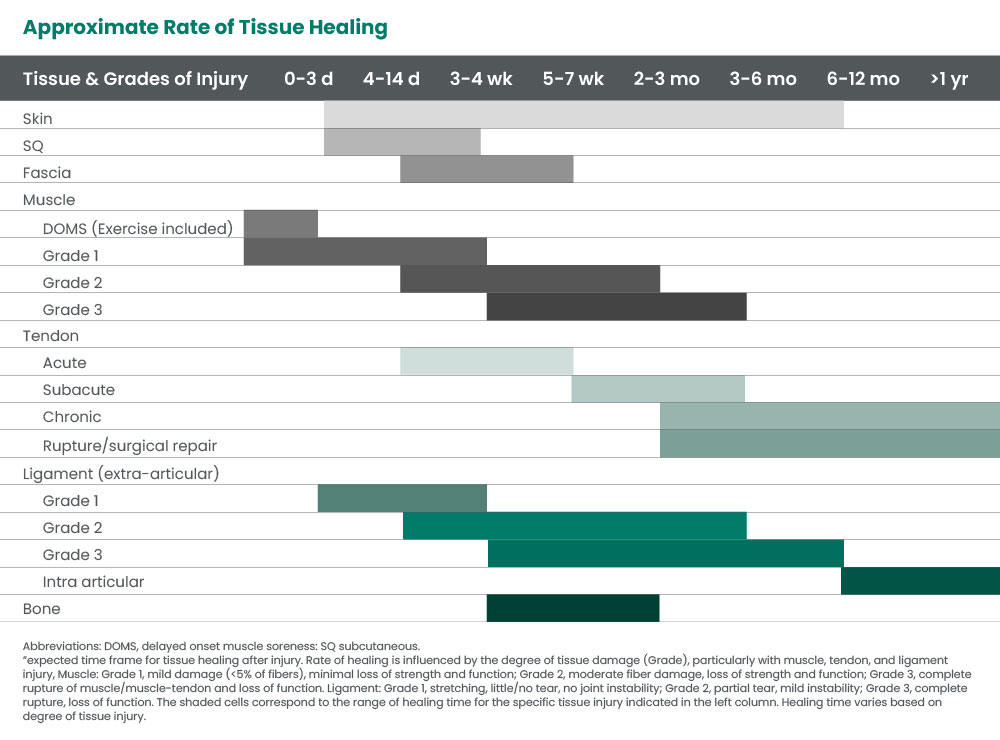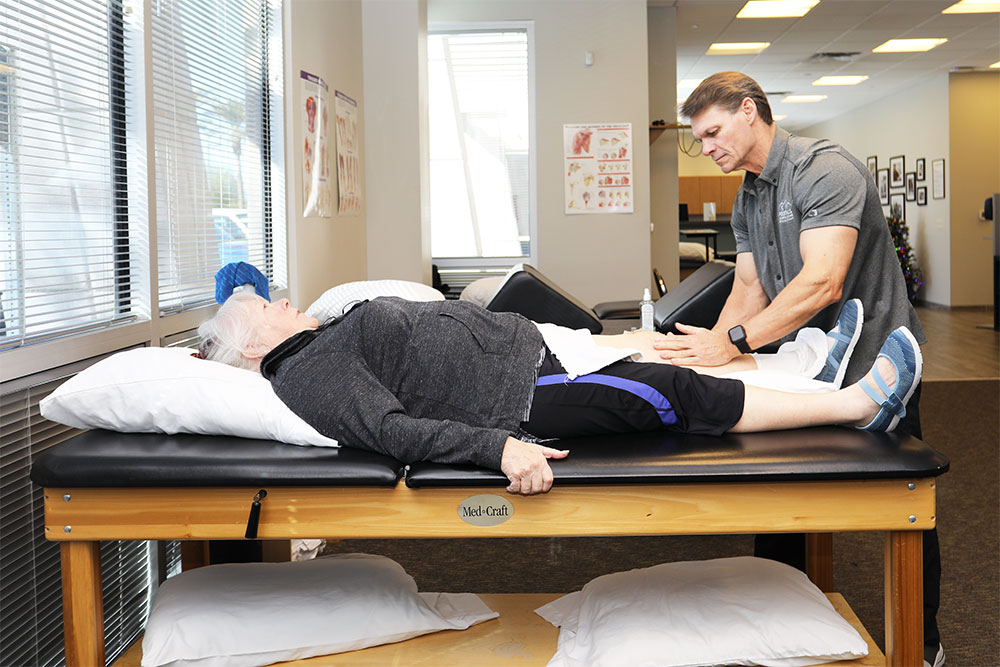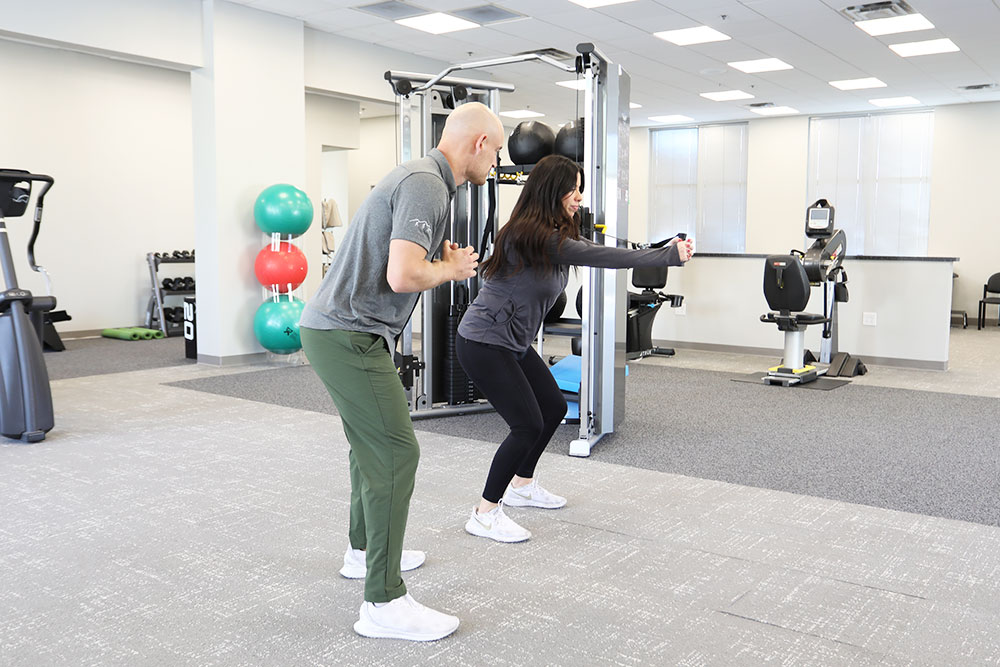It can often feel like a waiting game if you’re recovering from surgery or an injury. “How long will it take for my injury to heal?” is a common question our patients ask. Subsequently, our bodies are amazing at healing and adapting, but the healing process does take time, and in most cases, there are no quick fixes. The recovery time depends on the damaged tissue type and additional factors such as age, condition, nutrition, rest, etc. In this article, you will discover the general tissue healing timelines to help answer your questions or concerns.
Factors that Affect Tissue Healing
- Type of tissue
- The blood supply to the affected area
- Type and extent of damage
- Age and nutrition
- Medications
- Pre and post-injury care

Recovery Timeline for Tissue Types
Tissues are categorized into muscle, tendon, ligament, and bone, and each tissue comprises collagen, elastin, proteoglycans, and cells. Each tissue has specific properties: strength, extensibility (ability to stretch), elasticity (ability to recoil once stretched), and overall structure. Furthermore, knowing what type of tissue is injured is essential to appropriately estimate a time frame for healing and set appropriate rehabilitation expectations.
There are three tissue types:
1. Muscle
Over 400 muscles allow an individual to maintain their posture, move, and absorb shock while moving. At times, these muscles become overstressed, causing an injury to the muscle known as a muscle strain. A muscle strain is categorized from grade one to three based on how severe the tissue damage is.
Healing Timeline: 2 weeks to 6 months
Minor injuries may take only two weeks to heal, while severe injuries need three months or longer, with physical therapy, to recover. Surgery may sometimes be required, which also lengthens the healing time.

2. Tendon
Tendons connect muscles to bones and transmit forces generated by the muscles, allowing motion to occur. Tendon damage results from a direct cut, bruise, or overloading (too much pressure on the tendon), causing it to fail. Tendon injuries are categorized as strains and have similar healing times as muscles. If too much stress is put on the tendon, it can worsen the problem or even re-rupture. During rehab, attending physical therapy is crucial so the optimal stress and motion levels are applied and the tissue can re-form properly.
Healing Timeline: 3 weeks to a year
- Tendonitis: 3 weeks to 7 weeks
- Tendinosis: 3 months to 6 months
- Laceration: 5 weeks to 6 months
If surgical treatment is required, recovery times vary from four months to a year. Tendons enter the final stage of healing at seven weeks, but this process can take up to one year to complete.
3. Ligament
Ligaments connect bones to bones, providing stability to joints. They direct our motions and also prevent extreme movements that could cause injury. For example, ACL is one ligament prone to damage that may be far too familiar to some, especially in football, basketball, soccer, and gymnastics. ACL injuries may require surgery, but less severe ones do not.
Healing Timeline: 2 weeks to 1 year
Mild ligament sprains can take two to four weeks to heal, and moderate sprains may take more than ten weeks. If surgery is needed, the healing time increases from six months to a year.

4. Bone
Bones support the body and serve as attachment points for ligaments and tendons. Breaking a bone is not uncommon, and it can occur in any of the body’s 200+ bones. A fracture in larger bones can take up to 12 weeks to heal and up to a year for recovery. Interventions typically consist of surgery, immobilization in a cast, or time spent in a boot. Time and rest must be taken to reduce stress and allow the bone to heal correctly.
Healing Timeline: 5 weeks to 3 months.
A fracture in larger bones can take up to 3 months to heal and may not completely recover for up to a year. Healing time depends on the tissues involved and the severity of the injury.
Decrease Recovery Time with Physical Therapy
Physical therapists are trained to treat movement limitations. Working with a physical therapist will help aid and speed your recovery by:
- Facilitates healthy healing and reduces the risk of complications.
- Decreases pain
- Increases strength
- Increases mobility and flexibility
- Patient education and encouraging healthy habits and movement techniques.
Overview of Tissue Healing Timeframes
Tissue healing timeframes are based on acute conditions and negate other factors such as age, nutritional state, obesity, medical issues, and chronic conditions. We offer personalized, hands-on physical therapy and cutting-edge techniques to ensure your full recovery. Schedule a FREE assessment with one of our therapists today!




